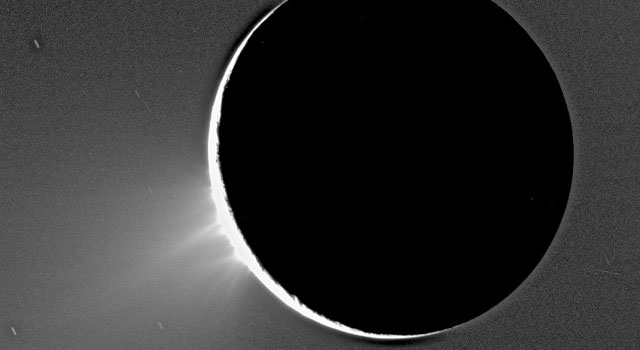[/caption]
In 2005, NASA’s Cassini spacecraft gave us an incredible view of Enceladus chuffing out fountains of water vapor and ice. This action creates an enormous halo of gas, dust and ice that surrounds this Saturnian satellite and enables the planet’s E ring. Now Enceladus is once again in the spotlight as the only moon in the Solar System known to significantly contribute to its parent planet’s chemistry.
Earlier this year, ESA announced that its Herschel Space Observatory had observed a huge torus of water vapor around Saturn which apparently originated from Enceladus. It spans approximately 600,000 kilometers across and runs about 60,000 kilometers deep, but more so than its size is what it appears to be doing… adding water to Saturn’s upper atmosphere. Because the vapor isn’t detectable at visible wavelengths, this observation came as revelation for the Herschel scope.
“Herschel is providing dramatic new information about everything from planets in our own solar system to galaxies billions of light-years away,” said Paul Goldsmith, the NASA Herschel project scientist at NASA’s Jet Propulsion Laboratory, Pasadena, California.
While the Herschel infrared observation is new, the indication of a vapor torus around Saturn isn’t. NASA’s Voyager and Hubble missions had given astronomers clues in the past. In 1997, the European Space Agency’s Infrared Space Observatory cited water in Saturn’s atmosphere and two years later NASA’s Submillimeter Wave Astronomy Satellite confirmed it again. But this confirmation only added up to a puzzle. Water found in Saturn’s lower cloud levels couldn’t rise past the colder, upper deck… So where was the water coming from? The answer came in the form of Herschel’s observations and some very astute computer modeling.
“What’s amazing is that the model, which is one iteration in a long line of cloud models, was built without knowledge of the observation.” says Tim Cassidy, a recent post-doctoral researcher at JPL who is now at the University of Colorado’s Laboratory for Atmospheric and Space Physics, Boulder. “Those of us in this small modeling community were using data from Cassini, Voyager and the Hubble telescope, along with established physics. We weren’t expecting such detailed ‘images’ of the torus, and the match between model and data was a wonderful surprise.”
Through these simulations, researchers hypothesized that much of the water in the torus was simply lost to space and some is pulled back by gravity to add material to Saturn’s rings. However, it’s the 3-5% that made it back to Saturn’s atmosphere that’s the most interesting. Just how much water vapor is out there? Thanks to combining information from both Herschel and the Ultraviolet Imaging Spectrograph (UVIS) instrument aboard the Cassini spacecraft, we’ve learned that about 12,000 kilograms is being ejected from Enceladus every minute. Can you image how much that would add up to in the period of a year… or more?!
“With the Herschel measurements of the torus from 2009 and 2010 and our cloud model, we were able to calculate a source rate for water vapor coming from Enceladus,” said Cassidy. “It agrees very closely with the UVIS finding, which used a completely different method.”
“We can see the water leaving Enceladus and we can detect the end product — atomic oxygen — in the Saturn system,” said Cassini UVIS science team member Candy Hansen, of the Planetary Science Institute, Tucson, Ariz. “It’s very nice with Herschel to track where it goes in the meantime.”
A tiny percentage adds up to some mighty big numbers, and the water molecules from the torus impact Saturn’s atmosphere to a great degree by contributing hydrogen and oxygen.
“When water hangs out in the torus, it is subject to the processes that dissociate water molecules,” said Hansen, “first to hydrogen and hydroxide, and then the hydroxide dissociates into hydrogen and atomic oxygen.” This oxygen is dispersed through the Saturn system. “Cassini discovered atomic oxygen on its approach to Saturn, before it went into orbit insertion. At the time, no one knew where it was coming from. Now we do.”
Very few days go by that we don’t learn something new about the Solar System and its inner workings. Thanks to observations like those done by the Herschel Space Observatory and missions like Cassini-Huygens, we’re able to further understand the dynamics behind the beauty… and how a tiny player can carry a major role.
“The profound effect this little moon Enceladus has on Saturn and its environment is astonishing,” said Hansen.
Original Story Source: JPL News Release.

